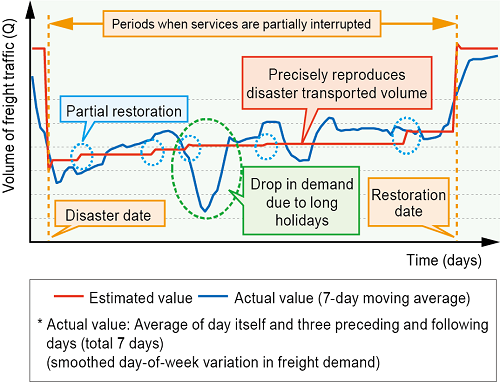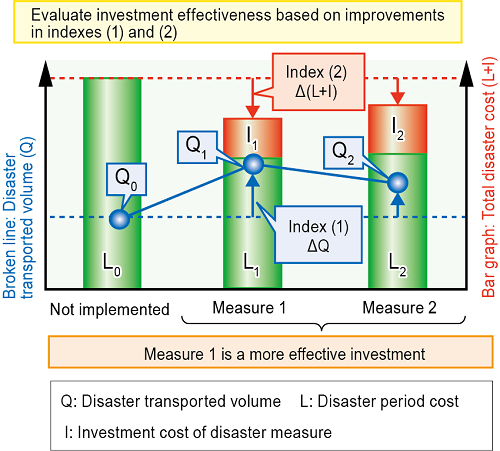20. Method of evaluating the effectiveness of investing in disaster countermeasures for freight transport
As natural disasters become more severe and frequent, effective disaster countermeasures are required to improve the disaster resilience of rail freight transport. However, quantitatively evaluating the effectiveness of such investments has been difficult.
To solve this problem, we considered periods when the railway network is partially interrupted due to a disaster.
We first developed a method for quantitatively determining the volume of freight traffic Q (hereafter, “disaster transported volume”), including detour transport and substitute truck transport, and the cost to rail freight operators L (hereafter, “disaster cost”). When we verified the validity of the developed method using actual freight transport data from past disasters, assuming no change in freight transport demand after the disaster, we confirmed that this method is capable of accurately estimating disaster transported volume, with the exception of periods when demand drops temporarily due to long consecutive holiday periods (Fig. 1).
Next, to evaluate the effectiveness of investments in disaster countermeasures, we developed a method focusing on disaster transported volume and the sum of disaster period costs L and disaster investment costs I (total disaster cost).
We calculated the difference in the disaster transported volume, ΔQ (Index 1) and the difference in the total disaster cost Δ(L+I) (Index 2), between the two cases in which disaster countermeasures are implemented and not implemented on railway networks. The disaster transported volume Q and disaster period cost L are calculated using the quantification method described earlier.
This method is used to obtain Index 1 and Index 2 for each disaster countermeasure and to evaluate the effectiveness of each investment (Fig. 2).
This method can be used to formulate various disaster countermeasures, such as improving disaster resilience by enhancing facilities at freight stations (“hard” measures) and expanding truck substitution routes (“soft” measures), as well as to identify the areas of the railway network where it is most beneficial to apply measures.
By replacing volume of freight traffic with that of passenger traffic, the method can be similarly used to evaluate the effectiveness of investments in disaster countermeasures for passenger transport on the same railway network.


